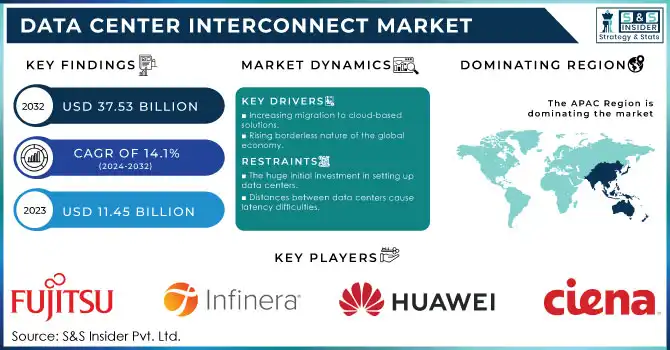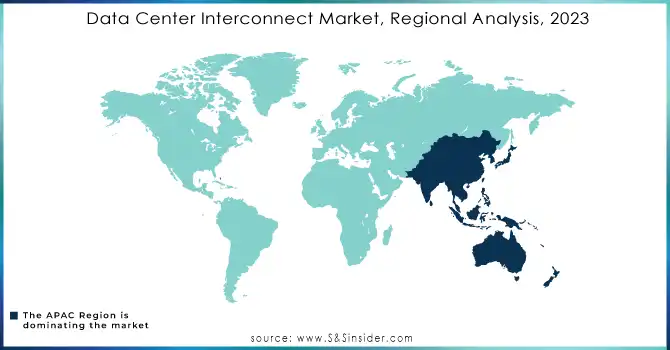Data Center Interconnect Market Size:

Get more information on Data Center Interconnect Market - Request Sample Report
The Data Center Interconnect Market Size was valued at USD 11.45 billion in 2023 and is expected to reach USD 37.53 billion by 2032 and grow at a CAGR of 14.1% over the forecast period 2024-2032.
Data Center Interconnect connects two or more data centers to achieve business or IT objectives. These connections enable them to work together, to delegate responsibilities, and to share information and resources.
Data Center Interconnect provides access to a variety of Internet service providers, which is important when a customer is in a different location. With this, businesses can demonstrate a strong internal and external presence to increase their customer base and business performance. Some large organizations use a data center interconnect to connect their data centers with their expanded infrastructure, while others connect to partners or cloud providers, or data center operators to enable simple data sharing, resource sharing, and handle disaster recovery needs.
Data Center Interconnect Market Dynamics:
KEY DRIVERS:
-
Increasing migration to cloud-based solutions.
-
Rising borderless nature of the global economy.
RESTRAINTS:
-
The huge initial investment in setting up data centers.
-
Distances between data centers cause latency difficulties.
OPPORTUNITIES:
-
Need for business continuity and disaster recovery.
-
The increasing digitization of financial services.
CHALLENGES:
-
Capacity limitations in data centers.
-
Security concerns.
IMPACT OF COVID-19:
COVID-19 has had a severe impact on the global economy as well as all industries. Governments in several countries have established borders to stop the plague from spreading. The initial phase of the epidemic's global shutdown in many countries has had a significant influence on people's lives and quality of life. As a result, the global supply chain has been shattered. The global economy has shrunk as commodity demand has decreased considerably. Due to the outbreak, which has caused a lack of immature materials, production in all industries has been slowed. Productivity declines are caused by variables such as depreciation and supply chain disruption.
The emergence of the global COVID-19 epidemic has hit the data center interconnect market. The construction of data centers has been suspended in some areas, but this has not been the case everywhere. Construction projects in some parts of Europe were completely shut down due to occupational safety. In addition, pre-construction activities such as permitting have been suspended. The response to Southeast Asia was mixed. Singapore had temporarily suspended construction, but Thailand allowed construction projects even though working days were reduced so that workers could return home by the time they got home. Within the construction, project management, service providers and suppliers are closely monitored to deliver. This ensured early identification of issues and selection of alternative solutions. The supply chains had some serious disruption.
Data Center Interconnect Market Segment Overview:
By Type, the data center interconnect market is subdivided into Product Software and service. Demand for services is expected to grow due to benefits such as critical targeted access and the development of a set of skills to improve their internal planning and management process to remotely manage customer IT infrastructure / end-user programs. The managed services market is expected to grow at a high rate during the forecast period due to its benefits, such as remote management of IT infrastructure for customers and end-user programs, generally in operation and under the registration model.
By End Users, the data center interconnect market is subdivided into Communication Service Providers, Internet Content Providers/ Carrier-Neutral Providers, Enterprises, Governments, and Others. DCI Market for Neutral Providers / Internet Content Providers is expected to prove a significant growth rate during the forecast period. Internet companies/internet content providers use multiple data centers and host thousands of servers. These data centers require terabits of visible transport over metro, regional, and long halls, which can be achieved by linking and transporting traffic between data centers using DCI. This requirement is expected to lead to a growing demand for DCI solutions by CNP and ICP during forecasting.
Data Center Interconnect Market Regional Analysis:
The market in APAC is expected to grow at a very high CAGR during the forecast period. Due to the presence of numerous emerging countries in the region, such as China, Japan, South Korea, and others, the APAC DCI market has a lot of room for expansion. These countries are seeing increased adoption of DCI networks due to increased investment and new development-related content. The APAC market for DCI is expected to grow across all verticals in the industry. The growing number of new data centers and innovations in DCI solutions drive the need for the adoption of DCI networks in the region.

Get a Customized Report as per your Business Requirement - Request For Customized Report
KEY PLAYERS:
The key players in the Data Center Power Market are Ciena Corporation, Huawei Technologies, Infinera Corporation, Cisco Systems, Fujitsu, XKL, Pluribus Networks, Evoque Data Center Solutions, Cyxtera Technologies, Nokia Corporation, Juniper Networks, ADVA Optical Networking, Extreme Networks, Colt Technology Services, Cologix, ZTE Corporation, Digital Realty Trust & Other Players.
| Report Attributes | Details |
|---|---|
| Market Size in 2023 | USD 11.45 Billion |
| Market Size by 2032 | USD 37.53 Billion |
| CAGR | CAGR of 14.1% From 2024 to 2032 |
| Base Year | 2023 |
| Forecast Period | 2024-2032 |
| Historical Data | 2020-2022 |
| Report Scope & Coverage | Market Size, Segments Analysis, Competitive Landscape, Regional Analysis, DROC & SWOT Analysis, Forecast Outlook |
| Key Segments | • By Type (Products, Software, Services) • By Application (Real-Time Disaster Recovery, Work Load Mobility, Shared Data Clusters, Data Storage Mobility, Others) • By Type (Loader, Crane, Forklift, Excavator, Dozer, Others) • By End-User (Communication Service Providers, Internet Content Providers/ Carrier-Neutral Providers, Enterprises, Governments, Others) |
| Regional Analysis/Coverage | North America (US, Canada, Mexico), Europe (Eastern Europe [Poland, Romania, Hungary, Turkey, Rest of Eastern Europe] Western Europe] Germany, France, UK, Italy, Spain, Netherlands, Switzerland, Austria, Rest of Western Europe]), Asia Pacific (China, India, Japan, South Korea, Vietnam, Singapore, Australia, Rest of Asia Pacific), Middle East & Africa (Middle East [UAE, Egypt, Saudi Arabia, Qatar, Rest of Middle East], Africa [Nigeria, South Africa, Rest of Africa], Latin America (Brazil, Argentina, Colombia, Rest of Latin America) |
| Company Profiles | Ciena Corporation, Huawei Technologies, Infinera Corporation, Cisco Systems, Fujitsu, XKL, Pluribus Networks, Evoque Data Center Solutions, Cyxtera Technologies, Nokia Corporation, Juniper Networks, ADVA Optical Networking, Extreme Networks, Colt Technology Services, Cologix, ZTE Corporation, Digital Realty Trust and Other. |
| Key Drivers | • Increasing migration to cloud-based solutions. • Rising borderless nature of the global economy. |
| Restraints | • Huge initial investment in setting up data centers. • Distances between data centers cause latency difficulties. |

